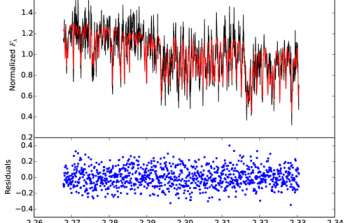sci16024 — Announcement
Gemini Confirms a Free-Floating Planet
February 16, 2016
Our observed spectrum of PSO J318.5−22 (black) compared to the forward model with our best fit parameters (red). The median residual of the fit is 0.079 (in normalized Fλ units), which is larger than the median uncertainty (0.048) of our observed spectrum. The rms of the residuals (0.12) indicates systematic uncertainties of ≈10%.
Gemini observations confirm the identity of an extremely red object as a planet. This is a free-floating member of the Beta Pictoris moving group. Spectral confirmation of the object’s group membership verifies the age, and therefore the mass estimate is more secure, at 8.3 ± 0.5 times the mass of Jupiter. K. Allers of Bucknell University led the work, which was based on observations using the Gemini Near-InfraRed Spectrograph (GNIRS) on the Gemini North telescope in a Director’s Discretionary time program. More information about this work is available at the Gemini webpage, and full results will appear in The Astrophysical Journal. A preprint is available now.
About the Announcement
| Id: |
ID
sci16024
|
